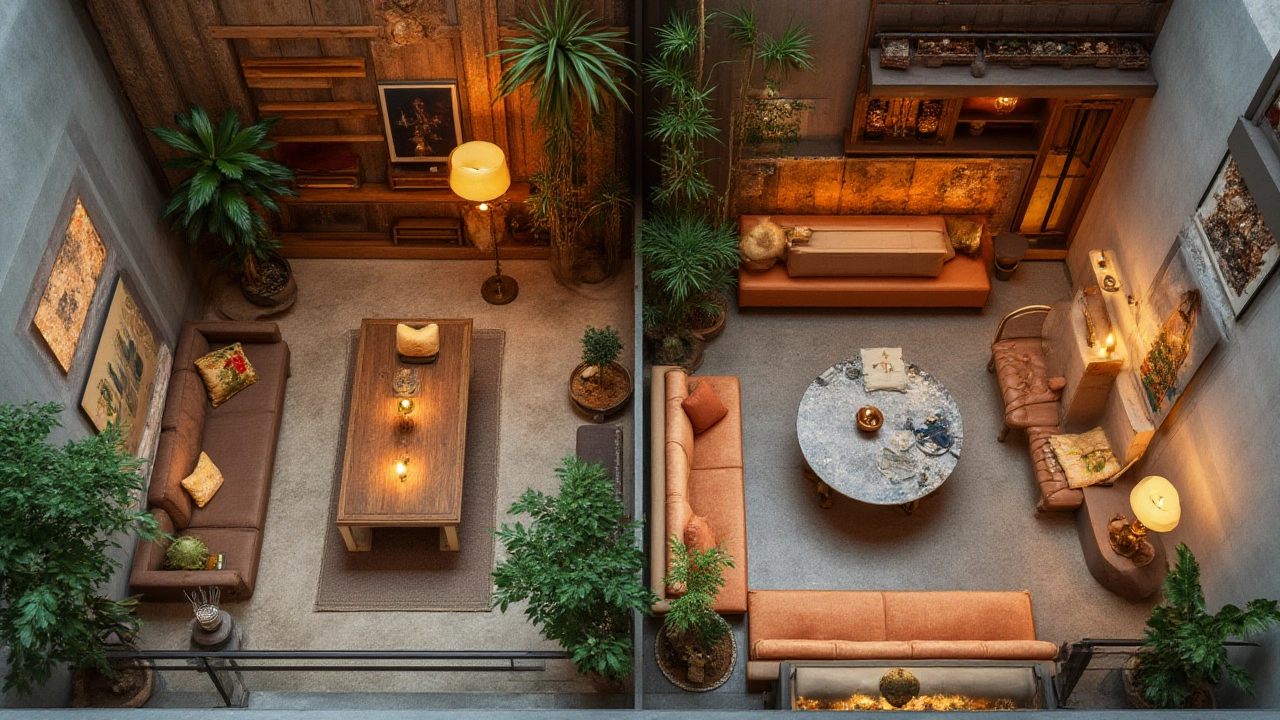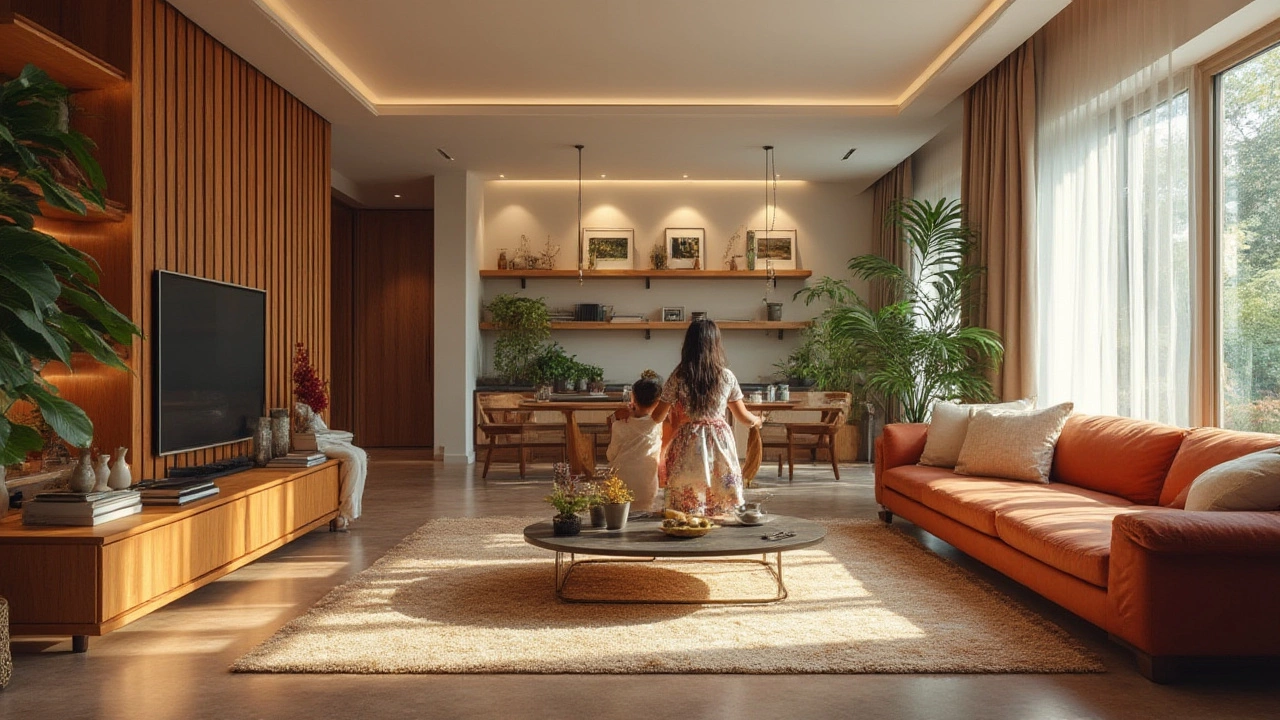Picture this: you’re standing in a jaw-dropping home, sunlight sliding across glossy floors, the furniture almost melting into its perfect spot, every detail so deliberate you could swear someone pressed pause on chaos. But wait—does it scream "modern" or is this "contemporary"? Even designers trip up here. These two design worlds overlap so much that most magazine spreads or TikToks get the label wrong. Yet, if you want your place to feel just right—or want to win your next debate at the dinner table—it actually pays to know what splits these two apart. The stakes? Well, your wallet, your time, and maybe how many times your friends compliment your taste.
Defining Modern and Contemporary Interiors: What Sets Them Apart?
Let’s untangle this. "Modern interior design" almost always refers to a very specific timeline: from the early 1900s (think Bauhaus, the clean lines of Le Corbusier) through mid-century (Eames, iconic wood-legged chairs, atomic lamps) and a bit past 1970. The modern movement was about breaking free from excessive ornamentation and embracing honest materials—bare wood, glass, steel—while letting form follow function. When you see a streamlined teak coffee table with barely a sliver of detail, or an open dining space with an Eileen Gray side table, that’s classic modern. In fact, the best-known modern design periods are Bauhaus, De Stijl, and Mid-Century Modern—that last one exploded in the U.S. after WWII, thanks to a housing boom and the influence of Scandinavian thinkers.
Contemporary interiors, on the other hand, are ever-shifting. Right now in 2025, what’s “contemporary” often means what’s trending this year. Take a walk in a newer luxury development and you might see sculptural pendant lamps, curved sofas, touch-of-black marble, eco-conscious materials, and hints of Japanese minimalism (Japandi) all mixing together. Give it a decade, and those trademarks could change again. That’s the core difference: modern is a snapshot in time, a set of movement-based design rules, while contemporary is always "what’s now." You’ll see the lines blurred, though, because today’s "contemporary" spaces often borrow bold shapes or furniture pieces straight from modern playbooks—but then remix them with something totally new, like smart glass walls or terrazzo side tables.
One of the best ways to tell the difference: ask, “Could I date this room to a particular era?” If everything fits a 1950s or 1960s design bible, it’s modern. If it drags in new colors, a viral TikTok lamp, or a truly odd-shaped couch that wasn’t even possible to make until five years ago, you’ve landed in contemporary territory. Modern is historical, contemporary is happening right now.
Key Features of Modern and Contemporary Interiors: Room By Room
Let’s wander through an imaginary home, starting with the living room. In a modern space, you’ll find low-slung furniture, often made from solid wood, leather, or steel. Picture a Florence Knoll sofa, glass-topped coffee tables, and those geometric walnut sideboards. The walls? Usually white, tan, or muted shades—colors that put the focus on lines and materials, not decoration. Accessories are almost sparse to the point of minimalism: a single abstract sculpture, a geometric rug, maybe a bold art print. Lighting too sticks to basics—arcs, globes, no frills. Modern interior design is all about letting shapes and materials speak loudly without much chatter.
Now let’s swing into a contemporary living room. At first glance, you might spot similarities: open layouts, neat forms, oversized windows. But look closer and you’ll see the mash-up. Sofas might curve or have odd angles; textiles run the gamut from vegan leather to smart-woven fabrics that resist spills. Walls are often neutral, but might have a pop—a giant moody mural, a patch of navy blue, or a dramatic matte finish. Floors could be polished concrete or engineered oak with radiant heat. Accessories pile on: textured throws, sculptural ceramics from Instagram artisans, maybe a playful wall planter. Lighting here can be wild—LED installations, sculptural fixtures, maybe even kinetic elements that move with sound or touch. Sustainability creeps in, too: repurposed materials, energy-efficient everything, and rarely a plastic bottle in sight.
In dining areas, modern keeps it simple—rectangular wooden tables, classic Wishbone or Cesca chairs, and pendant lights that don’t scream for attention. In contemporary spaces, the table might mix marble and metal, while chairs can clash purposefully (a nod to that “collected” look), finished off with a cluster of oversized globe lights or laser-cut statement pieces. The kitchen? For modern purists, it’s slab cabinets, stainless appliances, a nod to industrial utility, and almost no hardware visible. Contemporary kitchens right now love open shelving, hidden pantries, seamless induction cooktops, eco-friendly cabinetry (like bamboo or recycled glass), and even touchless faucets. Sometimes, the contemporary kitchen will throw in an aesthetic that looks almost like a café, with bold tile work and plenty of lived-in personality.
Beds in modern spaces make a statement with streamlined, low headboards and crisp linens—think walnut frames or even a simple platform resting quietly against an empty wall. Contemporary bedrooms crank up personalization: velvet headboards, built-in charging stations, backlit panels, and artful light fixtures. Some even have “wellness nooks” for stretching or meditation. Bathrooms? Modern design loves clean, spa-like spaces using terrazzo, steel, and frosted glass. Contemporary bathrooms dive deeper with bold tiling, floating vanities, double rain showers, smart toilets, or even heated floors controlled by phone apps.
There’s a trick to noticing what’s modern versus contemporary: zero in not only on the things you see, but on solutions that weren’t around fifty years ago. Seamless heated floors, app-controlled blinds, or that composting setup in the laundry room? All contemporary. A vibe like a scene from "Mad Men" or a James Bond home of the 1960s? You’re in modern territory.

Essential Facts, Surprising Ideas, and Smart Tips
Here’s where things get spicy. Did you know the “open floor plan” so common in modern interiors actually had its start in social housing prototypes in the 1920s? Architects like Le Corbusier were obsessed with light, health, and equality—and open layouts were meant to let sunlight reach every corner of the home. Fast-forward to today, and contemporary design takes this to wild new heights with fold-away walls or movable room dividers you can reconfigure by remote. The drive for adaptability is contemporary’s signature trick: people want their homes to shift with their lives, whether that means making room for hybrid work, yoga, or parties at a moment’s notice.
Here’s a wild fact I stumbled across: a study from the National Association of Home Builders in 2024 showed that 72% of new builds in North America mix both modern and contemporary elements—so, odds are even designers have stopped drawing a razor-sharp line. The point is, you don’t have to commit to just one. A modern sofa can live happily under a contemporary light sculpture, and it’ll look thoughtful instead of chaotic if you pick a simple color story. The best design is never just faithful imitation, but a remix that fits your real life.
Practical tip time: when I redid the dining room last year (yeah, I lost a good few weekends, but hey, the results speak), I started with a modern table and layered in contemporary chairs and a bold piece of local art. The best move was giving myself permission to swap out things often—a rotating centerpiece or a swappable pendant can breathe new life and keep things feeling "now." Want to dip a toe in both styles without blowing your budget? Focus on lighting or textiles, which let you change the vibe with little fuss.
Some real talk: don’t chase every TikTok trend or you’ll wind up with a room that feels dated before the paint dries. Anchor big-ticket pieces—sofas, tables, beds—in timeless modern shapes. Then, let contemporary color and accessories ebb and flow with your mood or the season.
The environmental edge is worth a shout, too. Modern spaces usually use heavy woods and steel, which can cost the planet a bit if you’re not picky. Contemporary solutions increasingly use upcycled or renewable materials, cork flooring, or low-VOC paints. It’s possible to go green and stay stylish. More than half of all new-build interiors in 2025 feature at least one eco-certification (thanks, stricter codes), so you don’t have to sacrifice style to be responsible.
And for a gem from the experts, here’s how renowned designer Patricia Urquiola puts it,
"The house is becoming less of a museum and more of a playground—people want spaces that shift, shapes that surprise, and the freedom to mix eras as long as it feels authentic."Couldn’t say it better myself.
Choosing What’s Right For You: Honest Advice and Next Steps
So where does that leave you, chasing the perfect vibe? Don’t stress about labels. The glory of this century is that it gives you permission to mix, cherry-pick, and break the rules. If your heart loves cool steel chairs and boxy oak tables, lean into the modern. If you’re itching to add a funky lamp or bold art, layer on the contemporary. Spaces feel best when they match your story, how you work, chill, or hang with friends. If you ever feel stuck, pinch inspiration from both sides—find a modern-style floor lamp, pair it with a trending throw, and see what clicks.
Try this quick exercise: close your eyes and picture your dream living room. Is it filled with clean lines, natural materials, and not much clutter? That’s modern. Does it flex with bold accessories, interesting shapes, and ever-changing details? That leans contemporary. Most people want a mix—and there’s no design police who’ll show up if you cross the streams. If you live with someone (my partner, Fiona, is very decisive about her lamp preferences), get a shared Pinterest board or mood folder going. Pin things, delete what makes you cringe, and notice which style you both circle back to. That’s your northern star.
Remember to test out your ideas in small doses before jumping in all the way. Try a rug, a new lamp, or a set of blinds—live with them, and scale up what works. And always—always—trust your instincts more than a catalog. The best interiors are the ones that work for you, not just the ones that fit a label. That’s the real difference between living in a house and loving your home.

